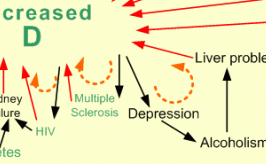Vitamin D reduces multiple sclerosis relapses, but not with interferon treatment
Two publications on this page by similar set of authors
Vitamin D and disease activity in multiple sclerosis before and during interferon-? treatment
Neurology June 12, 2012, 78 (24)
Kristin I. Løken-Amsrud, MD, Trygve Holmøy, PhD, Søren J. Bakke, PhD, Antonie Giaever Beiske, PhD, Kristian S. Bjerve, PhD, Bård T. Bjørnarå, PhD, Harald Hovdal, MD, Finn Lilleås, PhD, Rune Midgard, PhD, Tom Pedersen, PhD, Jurate Šaltyt? Benth, PhD, Leiv Sandvik, PhD, Øivind Torkildsen, PhD, Stig Wergeland, MD and Kjell-Morten Myhr, PhD
From the Department of Neurology (K.I.L.-A.), Innlandet Hospital Trust, Lillehammer; Department of Neurology (T.H., A.G.B.), Akershus University Hospital, Lørenskog; Institute of Immunology (T.H.), Department of Neuroradiology (S.J.B.), and Department of Biostatistics (L.S.), Oslo University Hospital, Oslo; Institute of Clinical Medicine (K.I.L.-A., T.H.), University of Oslo, Oslo; Departments of Medical Biochemistry (K.S.B.) and Neurology (H.H.), St. Olavs Hospital, Trondheim University Hospital, Trondheim; Helsehuset Kongsberg (B.T.B.), Kongsberg; Curato Oslo (F.L.), Oslo; Department of Neurology (R.M.), Molde Hospital, Molde; Unilabs Drammen (T.P.), Drammen; Helse Sør-Øst Health Services Research Centre (J.Š.), Akershus University Hospital, Lørenskog; Norwegian Multiple Sclerosis Competence Centre (Ø.T., S.W., K.-M.M.), Department of Neurology, Haukeland University Hospital, Bergen; Department of Clinical Medicine (K.-M.M.), University of Bergen, Bergen; and KG Jebsen MS-Research Centre (K.-M.M.), Bergen, Norway.
Correspondence & reprint requests to Dr. Holmøy trygve.holmoy@medisin.uio.no
Objective: Studies based on deseasonalized vitamin D levels suggest that vitamin D may influence the disease activity in multiple sclerosis (MS), and high doses are suggested as add-on treatment to interferon-? (IFN-?). Seasonal fluctuation of vitamin D varies between individuals, thus the relationship to disease activity should preferentially be studied by repeated and simultaneous vitamin D and MRI measurements from each patient.
Methods: This was a cohort study comprising 88 patients with relapsing-remitting MS who were followed for 6 months with 7 MRI and 4 25-hydroxyvitamin D measurements before initiation of IFN-?, and for 18 months with 5 MRI and 5 25-hydroxyvitamin D measurements during IFN-? treatment.
Results: Prior to IFN-? treatment, each 10 nmol/L increase in 25-hydroxyvitamin D was associated with 12.7% (p = 0.037) reduced odds for new T1 gadolinium-enhancing lesions, 11.7% (p = 0.044) for new T2 lesions, and 14.1% (p = 0.024) for combined unique activity. Patients with the most pronounced fluctuation in 25-hydroxyvitamin D displayed larger proportion of MRI scans with new T1 gadolinium-enhancing lesions (51% vs 23%, p = 0.004), combined unique activity (60% vs 32%, p = 0.003), and a trend for new T2 lesions (49% vs 28%, p = 0.052) at the lowest compared to the highest 25-hydroxyvitamin D level.
No association between 25-hydroxyvitamin D and disease activity was detected after initiation of IFN-?. HLA-DRB1*15 status did not affect the results.
Conclusion: In untreated patients with MS, increasing levels of 25-hydroxyvitamin D are inversely associated with radiologic disease activity irrespective of their HLA-DRB1*15 status.
Received September 1, 2011. Accepted December 14, 2011.
Copyright © 2012 by AAN Enterprises, Inc.
- - - - - - - - - - - - - - - - - -another publication by similar set of authors - - - - - - - - - - - - - - -
A randomised, double blind, placebo controlled trial with vitamin D3 as an add on treatment to interferon ?-1b in patients with multiple sclerosis.
Soilu-Hänninen M, Aivo J, Lindström BM, Elovaara I, Sumelahti ML, Färkkilä M, Tienari P, Atula S, Sarasoja T, Herrala L, Keskinarkaus I, Kruger J, Kallio T, Rocca MA, Filippi M
J Neurol Neurosurg Psychiatry 2012 May; 83(5):565-71.
To study the safety and efficacy of vitamin D3 as an add on therapy to interferon ?-1b (IFNB) in patients with multiple sclerosis (MS).
1 year, double blind, placebo controlled, randomised study in 66 MS patients.
The primary outcomes were T2 _burden of disease **(BOD) on MRI scans, proportion of patients with serum levels of 25-hydroxyvitamin D (25(OH)D) ?85 nmol/l or intact parathyroid hormone (PTH) ?20 ng/l, and number of adverse events.
Secondary outcomes were number of MRI enhancing T1 lesions and new T2 lesions, annual relapse rate, changes in the Expanded Disability Status Scale score, timed 25 foot walk test and timed 10 foot tandem walk tests.
Median change in BOD was 287 mm(3) in the placebo group and 83 mm(3) in the vitamin D group (p=0.105). Serum levels of 25(OH)D increased from a mean of 54 (range 19-82) nmol/l to 110 (range 67-163) nmol/l in the vitamin D group. 84% of patients reached a serum 25(OH)D level >85 nmol/l in the vitamin D group and 3% in the placebo group (p<0.0001).
Patients in the vitamin D group showed
fewer new T2 lesions (p=0.286) {which is not statistically significant} and a
significantly lower number of T1 enhancing lesions (p=0.004), as well as a
tendency to reduced disability accumulation (p=0.071) and to
improved timed tandem walk (p=0.076).
There were no significant differences in adverse events or in the annual relapse rate.
Vitamin D3 add on treatment to IFNB reduces MRI disease activity in MS.
EudraCT number 2007-001958-99 and ClinicalTrialsGov number NCT01339676.
See also VitaminDWiki
MS relapse rate reduced 14 percent for each 4 ng increase in vitamin D – May 2012
3X more vitamin D from the sun if take MS drug Interferon-? – July 2012
Neurology J. had 4 items on Multiple Sclerosis and Vitamin D – review by MS Soc Aug 2012
Overview MS and vitamin D which has the following
* MS is in a vicious cycle with vitamin D: low D ==> MS which lowers vitamin D__

- CLICK HERE for more about deficiencies and vicious cycles
